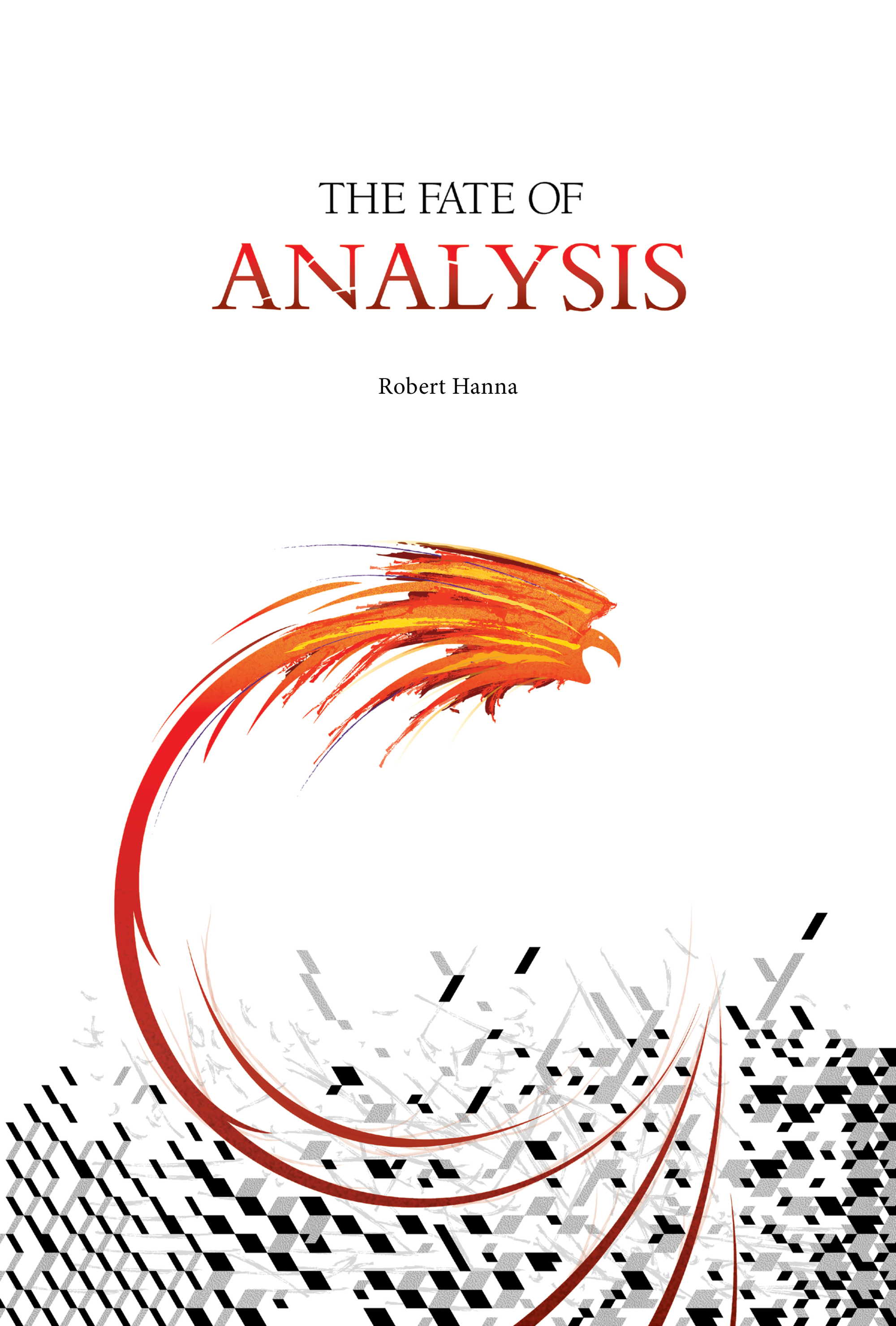ANALYTIC-SYNTHETIC*: The categorical distinction between (i) necessary truth in virtue of conceptual and/or logical content, such that this content is always taken together with some things in the vertically apparent or manifestly real world beyond conceptual and/or logical content, although its truth is never in virtue of those worldly things alone (aka analyticity), and (ii) necessary or contingent truth in virtue of things in the veridically apparent or manifestly real world beyond conceptual and/or logical content, as represented by essentially non-conceptual and non-logical content, such that this content is always taken together with some conceptual and/or logical content, although its truth is never in virtue of conceptual and/or logical content alone (aka syntheticity).
*Controversy: Just like the concept of the synthetic a priori—and indeed precisely because the analytic-synthetic distinction was originally framed by Kant so as to include the synthetic a priori—the problem of the nature, intelligibility, existence, and defensibility of the analytic-synthetic distinction, despite its seemingly abstruse and even irrelevantly Scholastic character, is probably the most contested, difficult, and fundamental problem in European and Anglo-American philosophy, from the publication of the first edition of the Critique of Pure Reason in 1781, all the way forward to 6am this morning (Hanna, 2001: chs. 3-5, 2015: ch. 4; 2021: ch. XVI).
ELABORATION
For the vast majority of Analytic philosophers, whether classical or post-classical, the analytic-synthetic distinction is merely an updated version of Hume’s Fork, which in turn is the two-pronged cognitive-semantic and epistemic distinction between (i) trivial, merely stipulative, necessary, and a priori “relations of ideas,” and (ii) substantive, empirical, contingent, and a posteriori “matters of fact.”
But in fact Kant’s original analytic-synthetic distinction was a three-pronged pitchfork designed for philosophical digging in the real earth of the veridically apparent or manifestly real world.
What I mean, is that it’s a threefold cognitive-semantic and epistemic distinction between (i) conceptually, logically, or “weakly metaphysically necessary” analytic a priori truths, (ii) non-logically, essentially non-conceptually, or “strongly metaphysically necessary” synthetic a priori truths, and (iii) contingent synthetic a posteriori truths.
In this way, the original Kantian analytic-synthetic distinction is nothing more and nothing less than the categorically sharp contrast between (i) necessary truth in virtue of conceptual and/or logical content, such that this content is always taken together with some things in the verdically apparent or manifestly real world beyond conceptual and/or logical content, although its truth is never in virtue of those worldly things alone, and (ii) necessary or contingent truth in virtue of things in the veridically apparent or manifestly real world beyond conceptual and/or logical content, as represented by essentially non-conceptual and non-logical content, such that this content is always taken together with some conceptual and/or logical content, although its truth is never in virtue of conceptual and/or logical content alone.
To be sure, there were anticipations of the original Kantian analytic-synthetic distinction in the writings of Locke, Hume, and Leibniz.
But since Kant is the official creator or discoverer of the original analytic-synthetic distinction—in the sense that he was the first to use that terminology, and the first to make it an absolutely central feature of his logic, semantics, epistemology, metaphysics, and ethics—then the question naturally arises: How did Kant’s Pitchfork turn into Hume’s Fork?
Here’s a much-simplified, blow-by-blow version of that deeply important historico-philosophical story.
In the 19th century and at the turn of the 20th, Bernard Bolzano, Gottlob Frege, and early Edmund Husserl all claimed to have purified Kant’s original tripartite analytic-synthetic distinction of its vitiating idealism and psychologism, and then Frege tried to reduce arithmetic truths to logically analytic truths by deriving them a priori from general logical laws together with something he called “logical definitions.”
At the fin de siècle and during the first decade of the 20th century, Moore and Russell attacked neo-Hegelian philosophy and Kant’s transcendental idealism, and asserted platonic atomism, according to which concepts and other universals are the primitive, ultimate constituents of propositions and reality alike, and can be known directly and self-evidently by acts or states of cognitive acquaintance.
In the 1920s and 30s, building on Wittgenstein’s theory of logic and meaning in the Tractatus, Rudolf Carnap and the other Vienna Circle logical empiricists/positivists rejected the very idea of the synthetic a priori, and adopted the conventionalist theory of analyticity.
Also in the 1930s, in “Truth by Convention,” Quine argued that the conventionalist theory of analyticity fails because its definition of logical truth or analyticity covertly presupposes and uses non-conventional classical logic.
Carnap responded to Quine in 1947, in the first edition of Meaning and Necessity.
In 1951, in “Two Dogmas of Empiricism,” Quine explicitly rejected the analytic-synthetic distinction as it was understood in “modern empiricism,” i.e., in logical empiricism/positivism—understood there as the distinction between (i) propositions (sentences, statements, judgments, beliefs, etc.) true by virtue of meaning alone, and (ii) propositions (sentences, statements, beliefs, judgments, etc.) true by virtue of their meaning together with matters of empirical fact—and proposed the elimination of the very idea of any analytic-synthetic distinction.
Carnap responded to Quine again in 1954, in the second edition of Meaning and Necessity.
Quine responded to Carnap in Word and Object (which, ironically enough, is dedicated to “RUDOLPH CARNAP, Teacher and Friend”) in 1960, and then again in “Carnap and Logical Truth” in 1963, and at the same time Quine strategically introduced the deflationary, ersatz, or epistemic-pragmatic version of the analytic-synthetic distinction between armchair beliefs, aka “the a priori,” and experimental beliefs, aka “the a posteriori.”
H.P. Grice and P.F. Strawson criticized Quine in 1956, in “In Defense of a Dogma.”
Strawson alone criticized Quine in 1957, in “Propositions, Concepts, and Logical Truths.”
Arthur Pap criticized Quine and defended the analytic-synthetic distinction at length in 1958, in Semantics and Necessary Truth.
And then Jerrold Katz criticized Quine in 1967, in “Some Remarks on Quine on Analyticity.”
Nevertheless, all this important philosophical work was in vain, and made no noticeable difference whatsoever.
By the end of the 1960s it had become the conventional wisdom that Quine had not only actually refuted the analytic-synthetic distinction, but also eliminated the very idea of any analytic-synthetic distinction, and not merely rejected them.
Indeed, by the early 1990s Tyler Burge could write this with a confident expectation of general agreement:
No clear reasonable support has been devised for a distinction between truths that depend for their truth on meaning alone and truths that depend for their truth on meaning together with (perhaps necessary) features of their subject matter. (Burge, 1992: pp. 9-10)
Then what happened after that?
Sadly, things went from bad to worse for Kant’s Pitchfork.
In the 1960s, 70s, and 80s, Kripke and Putnam (assisted by Keith Donnellan) rejected the very idea of a necessary equivalence between necessity and apriority by arguing for the existence of necessary a posteriori statements such as
(WH) Water is H2O
(GE) Gold is the element with atomic number 79
(CT) Cicero is Tully
and
(HP) Hesperus is Phosphorus
and also contingent a priori statements such as
(SM) Stick S is one meter long at t0 [According to Kripke]
(CA) Cats are animals [According to Putnam, but not Kripke]
(WL) Water is a liquid [According to Putnam, but not Kripke]
and
(WM) Whales are mammals [According to Donnellan, but not Kripke].
At the same time Ruth Barcan Marcus, Kripke, Putnam, David Kaplan, and Gareth Evans collectively developed Direct Reference Semantics, aka “The New Theory of Reference.”
Direct Reference Semantics explicitly includes the phenomena of ostensive dubbings, causal-historical chains of name-use, division of linguistic labor, contexts of utterance, and perceptual demonstration acts, as “meta-semantic” reference-determining mechanisms.
All of this, in turn, entails that the linguistic knowledge—including knowledge of the referent itself and as well as knowledge of the operating rules of the language—possessed by a competent user of directly referential terms, is minimal and often a posteriori.
Moreover, as a part of his logic of demonstratives and other indexicals, Kaplan also argued for the existence of analytic contingent statements in the logic of indexicals, for example,
(KAP) I am here now
In turn, “I am here now” is of course strongly reminiscent of Descartes’s famous proposition in Meditations on First Philosophy:
So after considering everything very thoroughly, I must finally conclude that this proposition, I am, I exist, is necessarily true whenever it is put forward by me or conceived in my mind. (Descartes, 1984: p. 17)
Descartes’s famous proposition then seemingly yields another analytic contingent statement that, in his 1986 book Cogitations, Katz very usefully dubs “The Existo”:
(EXISTO) I am, I exist.
And as if things were not already bad enough for Kant’s Pitchfork, in the 1980s and 90s, Graham Priest developed and defended the notion of radically non-classical or “deviant” dialetheic paraconsistent logics.
In such logics, contradictions can occur as theorems, and some propositions, sentences, or statements—known as “truth value gluts” or “true contradictions”—are assigned both the truth-value T and also the truth-value F, although contradictions are not permitted to “explode” and entail any sentence or statement whatsoever.
But in any case, it began to look as if even the seemingly self-evident universally necessary and analytic a priori law of non-contradiction could not hold up under critical scrutiny.
Then in the 1990s and early 2000s, some non-conformist post-classical Analytic philosophers like the later Putnam and John McDowell began to wonder what was left of the “Analytic” in “Analytic philosophy,” what it was all coming to, and whether it really was the end of the world as we know it.
Other mainstream post-classical Analytic philosophers just shrugged their shoulders, however, took their cue from the reductive, scientistic sides of Quine’s and Sellars’s work, and became scientific naturalists, and/or proponents of “Experimental Philosophy,” aka X-Phi, in the tradition of Hume and Mill.
But at the same time, some other leading post-classical Analytic philosophers—particularly including David Lewis at Princeton and other Lewis-influenced philosophers, created what I’ve called a Copernican Devolution in Philosophy—by going back behind the historical Kant to pre-Kantian noumenal metaphysics for guidance and inspiration (Hanna, 2017).
They call this “Analytic metaphysics,” a strategic label that nicely hides its epistemically and metaphysically naïve, pre-Kantian origins.
Most importantly, Analytic metaphysics self-professedly employs a rigorously “analytic” methodology.
Yet at the same time it has also avoided and still avoids discussing the analytic-synthetic distinction with remarkable tenacity, even despite its using the notions of “a priori intensions,” “a priori entailments,” and more generally a priori conceptual and modal-logical thinking, with remarkable liberality.
Even so, under the towering mushroom cloud of Quine’s critique, and since the late 1940s, at least nine important attempts have been made to reconsider, re-evaluate, re-interpret, re-criticize, or re-defend the analytic-synthetic distinction: (i) Carnap’s Meaning and Necessity in 1947 and 1956 (ii) Grice’s and Strawson’s “In Defense of a Dogma” in 1956, (iii) Pap’s Semantics and Necessary Truth in 1958, (iv) Paul Boghossian’s “Analyticity Reconsidered” in 1996, (v) Katz’s “The New Intensionalism” in 1992, and then five years later, (vi) his “Analyticity, Necessity, and the Epistemology of Semantics,” in 1997, (vii) Timothy Williamson’s The Philosophy of Philosophy in 2007, (viii) Gillian Russell’s Truth in Virtue of Meaning in 2008, and finally (ix) Cory Juhl’s and Eric Loomis’s Analyticity in 2010.
As I noted above in commenting on the critical responses to Quine up through the mid-60s, all this important philosophical work was in vain and made no noticeable difference whatsoever.
And that’s the way we live now until, inevitably, post-classical Analytic philosophy goes down into the ash-heap of history (Hanna, 2021: chs. XVII-XVIII)—just as its social-institutional predecessor, neo-Kantian philosophy, did in the late 1920s and early 30s, almost exactly a century ago.
REFERENCES
(Burge, 1992). Burge, T. “Philosophy of Language and Mind: 1950-1990.” Philosophical Review 101: 3-51.
(Descartes, 1984). Descartes, R. “Meditations on First Philosophy.” In R. Descartes, The Philosophical Writings of Descartes. Trans. J. Cottingham et al. 3 vols., Cambridge: Cambridge Univ. Press. Vol. 2. Pp. 3-62.
(Hanna, 2001). Hanna, R. Kant and the Foundations of Analytic Philosophy. Oxford: Clarendon/Oxford Univ. Press. Available online in preview at URL = <https://www.academia.edu/25545883/Kant_and_the_Foundations_of_Analytic_Philosophy>.
(Hanna, 2015). Hanna, R. Cognition, Content, and the A Priori: A Study in the Philosophy of Mind and Knowledge . THE RATIONAL HUMAN CONDITION, Vol. 5. Oxford: Oxford Univ. Press. Available online in preview at URL = <https://www.academia.edu/35801833/The_Rational_Human_Condition_5_Cognition_Content_and_the_A_Priori_A_Study_in_the_Philosophy_of_Mind_and_Knowledge_OUP_2015_>.
(Hanna, 2017c). Hanna, R. “Kant, the Copernican Devolution, and Real Metaphysics.”In M. Altman (ed.), Kant Handbook. London: Palgrave Macmillan. Pp. 761-789.
(Hanna, 2021). Hanna, R., The Fate of Analysis: Analytic Philosophy From Frege to The Ash-Heap of History. New York: Mad Duck Coalition. Affordably available in hardcover, softcover, and Epub at URL = <https://themadduckcoalition.org/product/the-fate-of-analysis/>.

If you feel so inclined, please feel free to show your support for Robert via his Patron page (https://www.patreon.com/philosophywithoutborders) or purchase his recently published book, The Fate of Analysis (2021).

The Fate of Analysis (2021)
Robert Hanna’s twelfth book, The Fate of Analysis, is a comprehensive revisionist study of Analytic philosophy from the early 1880s to the present, with special attention paid to Wittgenstein’s work and the parallels and overlaps between the Analytic and Phenomenological traditions.
By means of a synoptic overview of European and Anglo-American philosophy since the 1880s—including accessible, clear, and critical descriptions of the works and influence of, among others, Gottlob Frege, G.E. Moore, Bertrand Russell, Alexius Meinong, Franz Brentano, Edmund Husserl, The Vienna Circle, W.V.O. Quine, Saul Kripke, Wilfrid Sellars, John McDowell, and Robert Brandom, and, particularly, Ludwig Wittgenstein—The Fate of Analysis critically examines and evaluates modern philosophy over the last 140 years.
In addition to its critical analyses of the Analytic tradition and of professional academic philosophy more generally, The Fate of Analysis also presents a thought-provoking, forward-looking, and positive picture of the philosophy of the future from a radical Kantian point of view.







